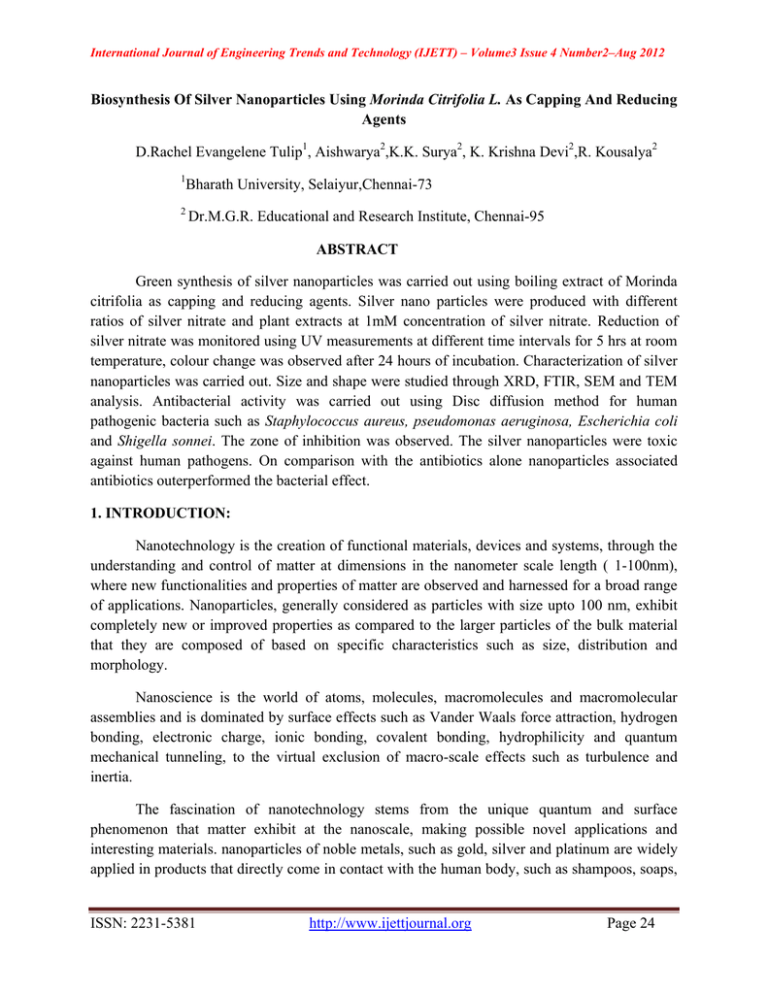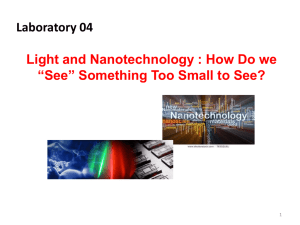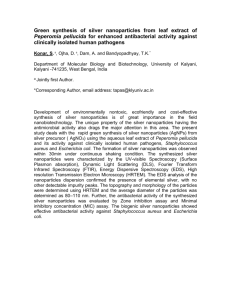Document 12908578
advertisement

International Journal of Engineering Trends and Technology (IJETT) – Volume3 Issue 4 Number2–Aug 2012 Biosynthesis Of Silver Nanoparticles Using Morinda Citrifolia L. As Capping And Reducing Agents D.Rachel Evangelene Tulip1, Aishwarya2,K.K. Surya2, K. Krishna Devi2,R. Kousalya2 1 Bharath University, Selaiyur,Chennai-73 2 Dr.M.G.R. Educational and Research Institute, Chennai-95 ABSTRACT Green synthesis of silver nanoparticles was carried out using boiling extract of Morinda citrifolia as capping and reducing agents. Silver nano particles were produced with different ratios of silver nitrate and plant extracts at 1mM concentration of silver nitrate. Reduction of silver nitrate was monitored using UV measurements at different time intervals for 5 hrs at room temperature, colour change was observed after 24 hours of incubation. Characterization of silver nanoparticles was carried out. Size and shape were studied through XRD, FTIR, SEM and TEM analysis. Antibacterial activity was carried out using Disc diffusion method for human pathogenic bacteria such as Staphylococcus aureus, pseudomonas aeruginosa, Escherichia coli and Shigella sonnei. The zone of inhibition was observed. The silver nanoparticles were toxic against human pathogens. On comparison with the antibiotics alone nanoparticles associated antibiotics outerperformed the bacterial effect. 1. INTRODUCTION: Nanotechnology is the creation of functional materials, devices and systems, through the understanding and control of matter at dimensions in the nanometer scale length ( 1-100nm), where new functionalities and properties of matter are observed and harnessed for a broad range of applications. Nanoparticles, generally considered as particles with size upto 100 nm, exhibit completely new or improved properties as compared to the larger particles of the bulk material that they are composed of based on specific characteristics such as size, distribution and morphology. Nanoscience is the world of atoms, molecules, macromolecules and macromolecular assemblies and is dominated by surface effects such as Vander Waals force attraction, hydrogen bonding, electronic charge, ionic bonding, covalent bonding, hydrophilicity and quantum mechanical tunneling, to the virtual exclusion of macro-scale effects such as turbulence and inertia. The fascination of nanotechnology stems from the unique quantum and surface phenomenon that matter exhibit at the nanoscale, making possible novel applications and interesting materials. nanoparticles of noble metals, such as gold, silver and platinum are widely applied in products that directly come in contact with the human body, such as shampoos, soaps, ISSN: 2231-5381 http://www.ijettjournal.org Page 24 International Journal of Engineering Trends and Technology (IJETT) – Volume3 Issue 4 Number2–Aug 2012 detergents, shoes, cosmetic products and toothpaste, besides medical and pharmaceutical application. Novel metal nanocrystallites such as silver and gold provide a more interesting research field due to their conduction and valence bonds in which electrons move freely. The free electrons give rise to a surface Plasmon absorption band, which depends on both the particles size and chemical surroundings. In the last five years, much effort has been expended on their organization on surfaces for the construction of functional interfaces. 2. MATERIALS AND METHODS: Silver nitrate solution purchased from HiMedia Laboratories Pvt. Limited, Mumbai, India. The Morinda citrifolia was obtained from coastal regions of kerala. 2.1. PREPARATION OF AQUEOUS SILVER NITRATE: 1mM silver nitrate solution was prepared in 100 ml deionized water. 2.2. PREPARATION OF EXTRACT BY CONVENTIONAL METHOD: The Morinda citrifolia leaves were washed several times with deionised water. 50gm of finely cut Morinda citrifolia leaves were taken and boiled in 150ml of double distilled water for 3min and filtered. Centrifuged at 6000rpm for 20mins. Collect the supernatant and store at 4°C. 2.3. PREPARATION OF EXTRACT BY HOMOGENIZATION METHOD: THE Morinda citrifolia leaves were washed several times with deionised water. 50g of the leaves were homogenized in 150ml water with the help of mortar and pestle anf filtered. Then the filterate was centrifuged for 30 min at 6000rpm and supernatant was collected. Collect the supernatant and store at 4°C. 2.4. SYNTHESIS OF SILVER NANOPARTICLES: 15ml of Morinda citrifolia extract was added to 9ml of 1mM AgNO3 separately and kept at room temperature. Bioreduction of silver ions in the solution were monitored by measuring using UV spectra of the solution at periodic intervals. The nanoparticle synthesized was confirmed by UV spectra plasma curve. The solution was centrifuged and the particles were characterized. 2.5. UV –Vis SPECTRA ANALYSIS: The bioreduction of Ag+ in aqueous solution was monitored by periodic sampling of aliquots (0.2ml) of the suspension, then diluting the samples with 2ml deionized water and subsequently measuring UV-Vis spectra, at the wave length of (400-500). UV-Vis spectra were recorded for 4 hrs. ISSN: 2231-5381 http://www.ijettjournal.org Page 25 International Journal of Engineering Trends and Technology (IJETT) – Volume3 Issue 4 Number2–Aug 2012 2.6. RECOVERY OF SILVER NANOPARTICLES BY CENTRIFUGATION: After bioreduction, the solution consisting of hydrosols of silver nanoparticles was subjected to centrifugation at 6000 rpm for 20 min, and the supernatant was discarded. The pellet formed was dissolved in 0.1 ml of toluene water and air dried. 3. RESULT AND DISSCUSION: 3.1. BIOSYNTHESIS OF SILVER NANOPARTICLES: Biosynthesis of silver nanoparticles by the filtrate of Morinda citrifolia was confirmed by change in the colour of the filtrate to brown after addiction of silver nitrate. This arises due to excitation of surface Plasmon vibrations in the metal nanoparticles. (a) (b) Figure 1: Synthesis of silver nanoparticles (a) Before reaction (b) After Reaction 3.2. UV-VIS SPECTRAL ANALYSIS: The bioreduction of Ag+ in aqueous solution was monitored by periodic sampling of the reaction mixture at regular intervals by using UV-Vis spectroscopy. Fig shows a strong characteristic absorbance peak at around 450nm throughout the reaction period. Analysis by spectrophotometer was made up to 5hrs experiment. ISSN: 2231-5381 http://www.ijettjournal.org Page 26 International Journal of Engineering Trends and Technology (IJETT) – Volume3 Issue 4 Number2–Aug 2012 Figure 2.: UV-Vis spectroscopy of silver nanoparticle .3.3. CHARACTERIZATION OF SILVER NANOPARTICLES: 3.3.1. XRD: XRD analysis showed three distinct diffraction peaks at 27.56°, 31.92°, 45.75° and can be indexed the angle values of (60), (100), (35) crystalline planes of sphere Ag. This analysis revealed that nanoparticles are in orthorhombic crystals. The high peaks in the analysis indicate the active silver composition with the indexing. Figure 3. The XRD pattern of the siver nanoparticles formedin our experiment. ISSN: 2231-5381 http://www.ijettjournal.org Page 27 International Journal of Engineering Trends and Technology (IJETT) – Volume3 Issue 4 Number2–Aug 2012 3.3.2. FTIR ANALYSIS FTIR spectral analysis showed array of absorbance bands in 500 cm-1 – 4000 cm-1 . The spectral band peaks are along the range of between 600 cm-1 – 4000 cm-1 with prominent peaks at 674.3 cm-1 , 1072.1 cm-1, 1261.5 cm-1, 1651.7 cm-1, 2080.2 cm-1, 2926 cm-1 and 3398.3 cm-1 which were interpreted for the identification of the functional moieties in the air dried silver nanoparticles. Figure 4: The FTIR graph of silver nanoparticles. 3.3.3. SEM ANALYSIS: Scanning electron microscope analysis of the silver nitrate solution (Control) and reduced form of silver nitrate solution are clearly distinguishable owing to their size difference. It is clear from the SEM pictures that control silver nitrate particles are more than 1000 Mn size, where as silver particles in the bioreduced colloidal suspensions measured 20-40nm in size. Figure 5: SEM analysis of silver nitrate ISSN: 2231-5381 http://www.ijettjournal.org Page 28 International Journal of Engineering Trends and Technology (IJETT) – Volume3 Issue 4 Number2–Aug 2012 Figure 6: SEM analysis of silver nanoparticle 1 µm Figure 7: SEM analysis of silver nanoparticle 5 µm 3.2.3 TEM ANALYSIS: TEM analysis revealed that the synthesized nanoparticles are stable in solution at room temperature. The size of nanoparticle range from 20 - 40nm. The decrease in anisotrophy and particle size is evident from the images. The TEM images revealed equal spherical shape. ISSN: 2231-5381 http://www.ijettjournal.org Page 29 International Journal of Engineering Trends and Technology (IJETT) – Volume3 Issue 4 Number2–Aug 2012 Figure 8: TEM analysis of silver nanoparticle in 150nm 3.4. ANTIBACTERIAL ACTIVITY OF SILVER NANOPARTICLES AGAINST HUMAN PATHOGENIC BACTERIA: 3.4.1. DISC DIFFUSION METHOD: Zone of inhibition in the plate showed that silver nanoparticles synthesized using filtrate have the antibacterial activity against test pathogens namely Staphylococcus aureus, Pseudomonas aeruginosa, Escherichia coli and Shigella sonnei. On comparison with the antibiotics alone nanoparticles associated antibiotics outerperformed the bactericidal effect. Antibacterial activity of silver nanoparticle with ciprofloxin 1. Staphylococcus aureus 2. Pseudomonas aeruginosa 11 ISSN: 2231-5381 http://www.ijettjournal.org Page 30 International Journal of Engineering Trends and Technology (IJETT) – Volume3 Issue 4 Number2–Aug 2012 3. Shigella sonnei Organism S.auerus P. aeruginosa S. sonnei E. coli Np 11 14 15 10 4. Escherichia coli Np+ A 32 30 26 32 A 30 26 24 29 4. CONCLUSIONS: Addition of 1mM silver nitrate solution into filtrate led the appearance of yellowish brown colour as a resultant of formation of silver nanoparticles in the solution. The UV-Vis absorption spectrum recorded for the reaction solution shows the characteristic surface Plasmon resonance band for silver nanoparticles in the range of 420-460nm. The reddish brown colour appears after 24hrs of incubation on the addition of the silver nitrate into liquid filtrate. The SEM studies confirmed the formation of silver particles in the size range of 1520nm, a clear indication of the formation of silver nanoparticles. The characterization of silver nanoparticles by TEM studies revealed the average grain size to be 35nm. XRD of silver nanoparticles was with crystalline planes (60), (100), (35) corresponding t spherical shape of silver nanoparticles. FTIR analysis was used to characterize the nature of capping ligands that stabilizes the silver nanoparticles formed by bioreduction process. The FTIR spectrum showed bands at 674.3cm-1 and 2926 cm-1 corresponds to –C-H bending and stretching vibrations, while the band at 1072.1 is characteristic of amine (-C-N) and carboxylic (-C-O) stretching groups. The absorbance band at 1261.5 is characteristic of –C-N amine group and –NO2 nitro compound stretching. The absorbance band at 1651.7 is characteristic of –NO2 notro compound and –C=C alkenes stretching. The absorbance band at 3398.3 is characteristics of amine –N-H and hydroxyl ISSN: 2231-5381 http://www.ijettjournal.org Page 31 International Journal of Engineering Trends and Technology (IJETT) – Volume3 Issue 4 Number2–Aug 2012 –O-H groups stretching and the absorbance band formed at 2080 is characteristics of alkynes – C≡C groups stretching. We have found that the silver nanoparticles synthesized in our study effectively inhibitedthe growth and multiplication of human pathogenic bacteria like Staphylococcus aureus, Pseudomonas aeruginosa, Eschericia coli and Shigella sonnei. The silver nanoparticles treated cultures exhibited reduced/almost no metabolic rates when compared with untreated bacterial cultures. This can be attributed to the inhibition activity of silver nanoparticles on the respiratory enzymes (cytochrome oxidases , malate dehydrogenase and succinate dehyrogenase) or as a result of complete destruction of the bacteria. But yet more experimental data in this regard is necessary to support the idea. REFERENCES: 1. Vorobyova SA, Lesnikovich AI, Sobal NS (1999) Preparation of silver nanoparticles by interphase reduction. Colloid Surf A 152:375–379 2. Bae CH, Nam SH, Park SM (2002) Formation of silver nanoparticles by laser ablation of a silver target in NaCl solution. Appl Surf Sci 197:628–634 3. Mandal D, Blonder ME, Mukhopadhyay D, Sankar G, Mukherjea P (2000) The use of microorganisms for the formation of metal nanoparticles and their application. Appl Microbiol Biotechnol 69:485–492 4. Basavaraja S, Balaji DF, Lagashetty A, Rajasab AH, Venkataraman A (2008) Extracellular biosynthesis of silver nanoparticles using the fungus Fusarium semitectum. Mater Res Bull 43:1164–1170 5. Kowshik M, Ashtaputre S, Kharrazi SS, Vogel W, Urban J, Kulkarni SK, Paknikar M (2003) Extracellular synthesis of silver nanoparticles by a silver-tolerant yeast strain MKY3. Nanotechnology 14:95–100 6. Keki S, Torok J, Deak G (2000) Silver nanoparticles by PAMAM-assisted photochemical reduction of Ag+. J Colloid Interface Sci 229:550–553 7. Jha AK, Prasad K (2010) Green synthesis of silver nanoparticles using Cycas leaf. Inter J Green Nanotechno: Phys Chem 1:110–117 ISSN: 2231-5381 http://www.ijettjournal.org Page 32 International Journal of Engineering Trends and Technology (IJETT) – Volume3 Issue 4 Number2–Aug 2012 8. Yu D-G (2007) Formation of colloidal silver nanoparticles stabilized by Na+ −poly(gamma-glutamic acid)-silver nitrate complex via chemical reduction process. Colloids Surf B 59:171–178 9. He S, Guo Z, Zhang Y, Zhang S, Wang J, Gu N (2007) Biosynthesis of gold nanoparticles using the bacteria Rhodopseudomonas capsulate. Mater Lett 61:3984–3987 10. Leela A, Vivekanandan M (2008) Tapping the unexploited plant resources for the synthesis of silver nanoparticles. Afr J Biotechnol 7:3162–5315 11. Song JY, Kim BS (2009) Rapid biological synthesis of silver nanoparticles using plant leaf extract. Bioprocess Biosyst Eng 32:79–84 12. Bar H, Bhui DK, Gobinda SP, Sarkar PM, Pyne S, Misra A (2009) Green synthesis of silver nanoparticles using seed extract of Jatropha curcas. Physicochem Eng Aspects 348:212–216 13. Bankar A, Joshi B, Kumar AR, Zinjarde S (2009) Banana peel extract mediated novel route for synthesis of silver nanoparticles. Colloid Surf A Physicochem Eng Aspect 368:58–63 14. Dwivedi AD, Gopal K (2010) Biosynthesis of silver and gold nanoparticles using Chenopodium album leaf extract. Colloid Surf A Physicochem Eng Aspect 369:27–33 15. Dubey SP, Lahtinen M, Sillanpaa M (2010) Green synthesis and characterization of silver and gold nanoparticles using leaf extract of Rosa rugosa. Colloid Surf A Physicochem Eng Aspect 364:34–41 16. Geethalakshmi E, Sarada DV (2010) Synthesis of plant-mediated silver nanoparticles using Trianthema decandra extract and evaluation of their anti microbial activities. Int J Eng Sci Tech 2:970–975 17. Nabikhan A, Kandasamy K, Raj A, Alikunhi NM (2010) Synthesis of ISSN: 2231-5381 http://www.ijettjournal.org Page 33 International Journal of Engineering Trends and Technology (IJETT) – Volume3 Issue 4 Number2–Aug 2012 antimicrobial silver nanoparticles by callus and leaf extracts from saltmarsh plant, Sesuvium portulacastrum L. Colloids Surf B Biointerfaces 79:488–493 18. Christensen L, Vivekanandhan S, Misra M, Mohanty AK (2011) Biosynthesis of silver nanoparticles using murraya koenigii (curry leaf): an investigation on the effect of broth concentration in reduction mechanism and particle size. Adv Mater Letters 2:429–434 19. Vidhu VK, Aromal A, Philip D (2011) Green synthesis of silver nanoparticles using Macrotyloma uniflorum. Spectrochim Acta A Mol Biomol Spectros 83:392–397 20. Ahmad N, Sharma S, Alam MK, Singh VN, Shamsi SF, Mehta BR, Fatma A (2010) Rapid synthesis of silver nanoparticles using dried medicinal plant of basil. Colloids Surf B Biointerfaces 81(1):81–86 ISSN: 2231-5381 http://www.ijettjournal.org Page 34






